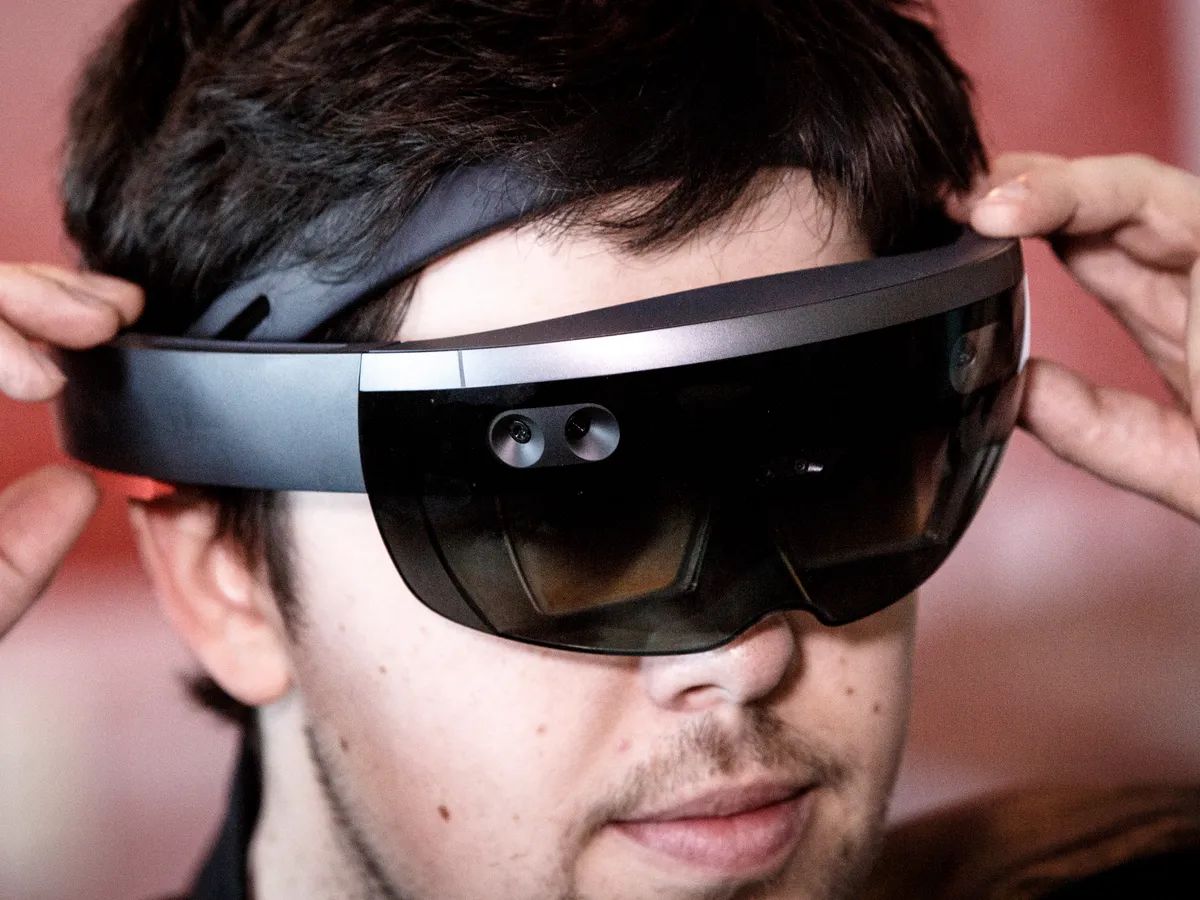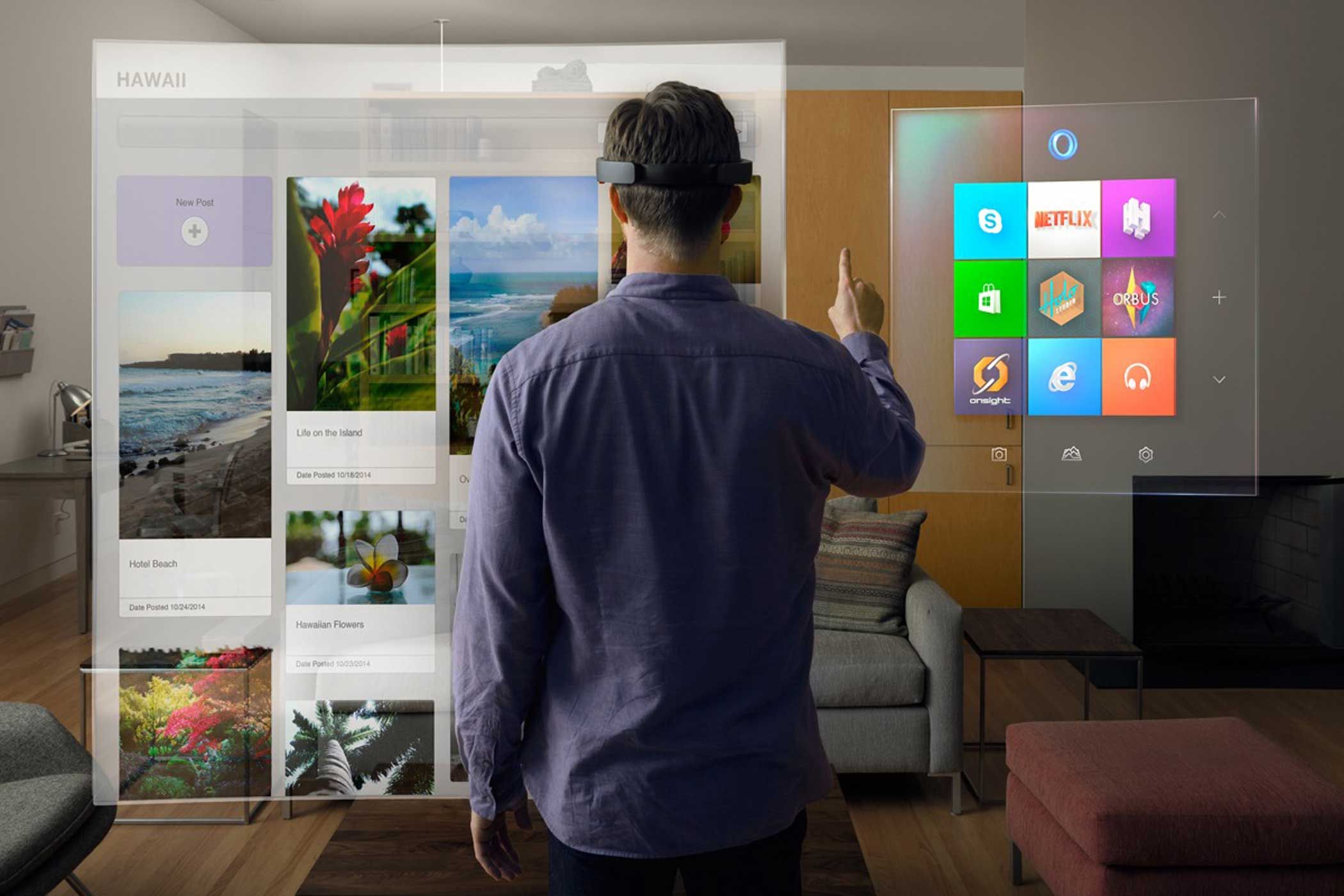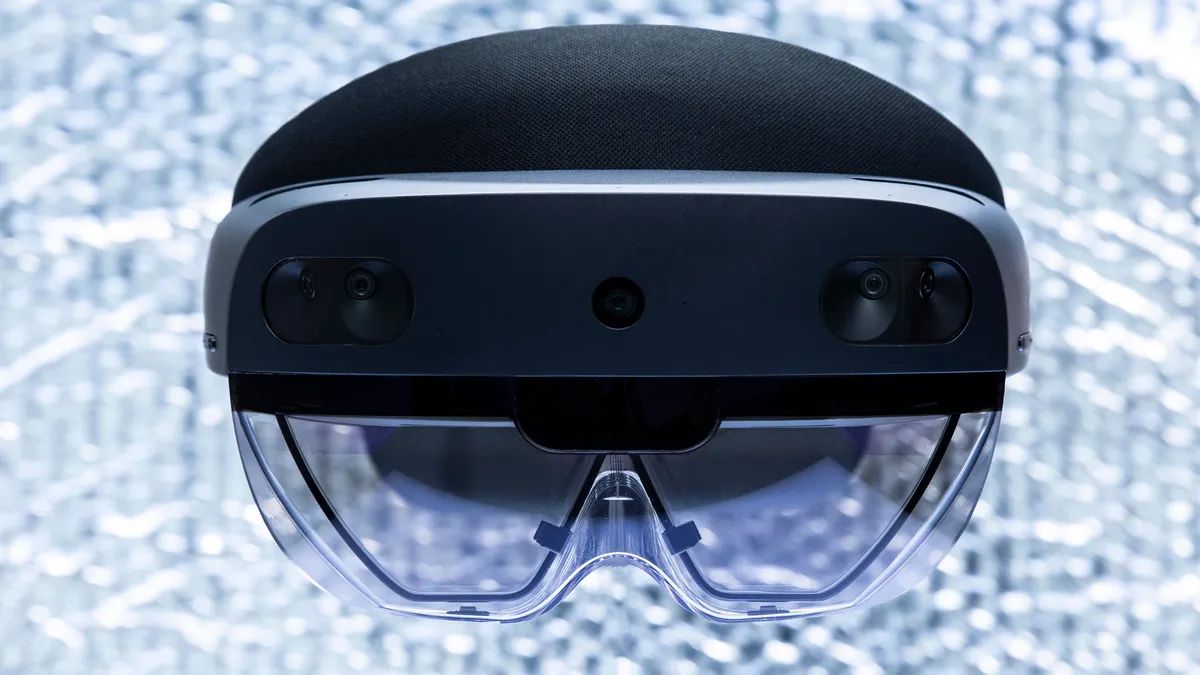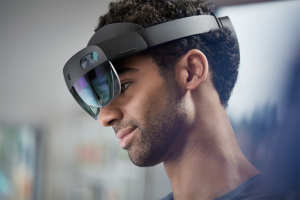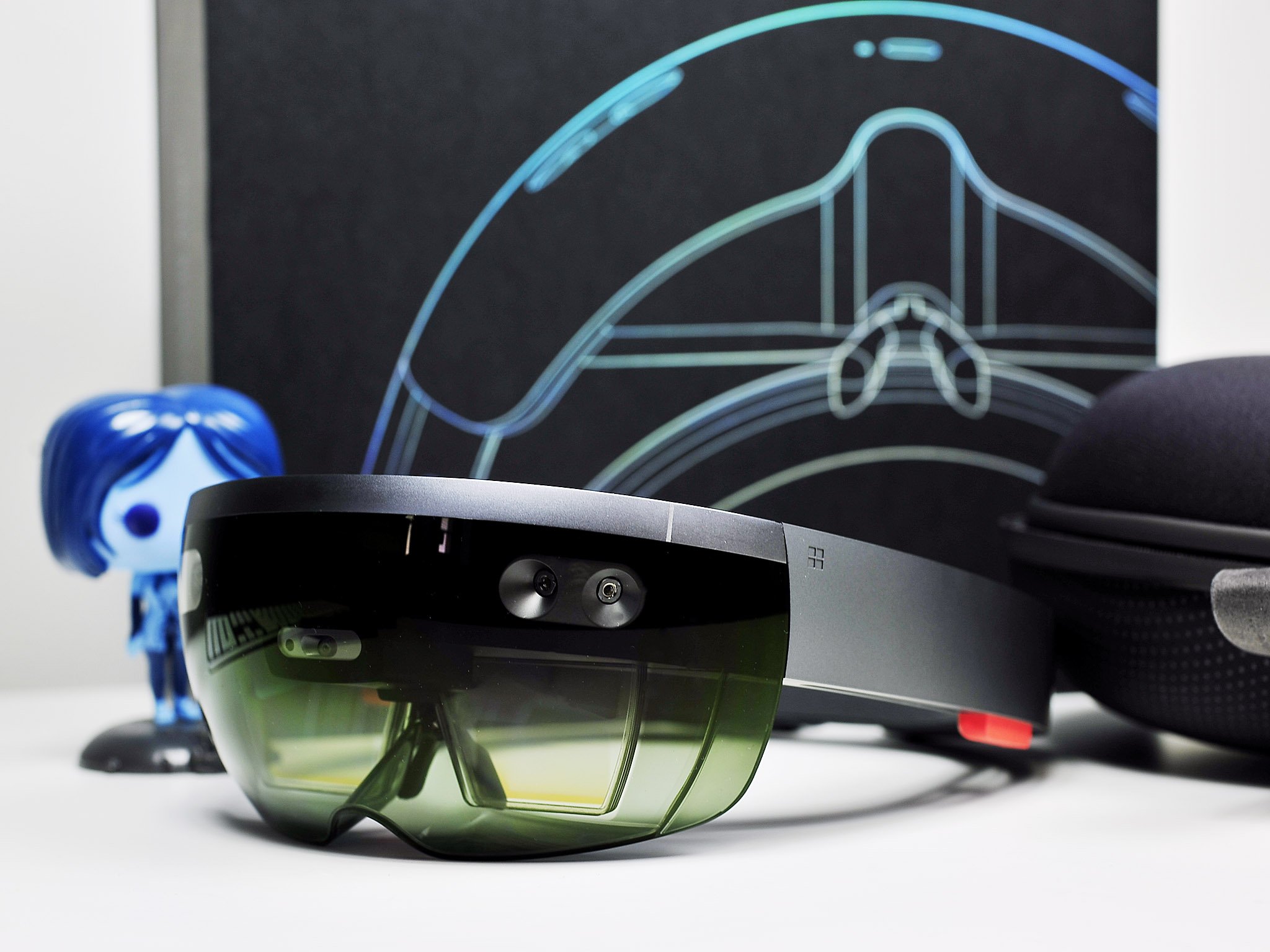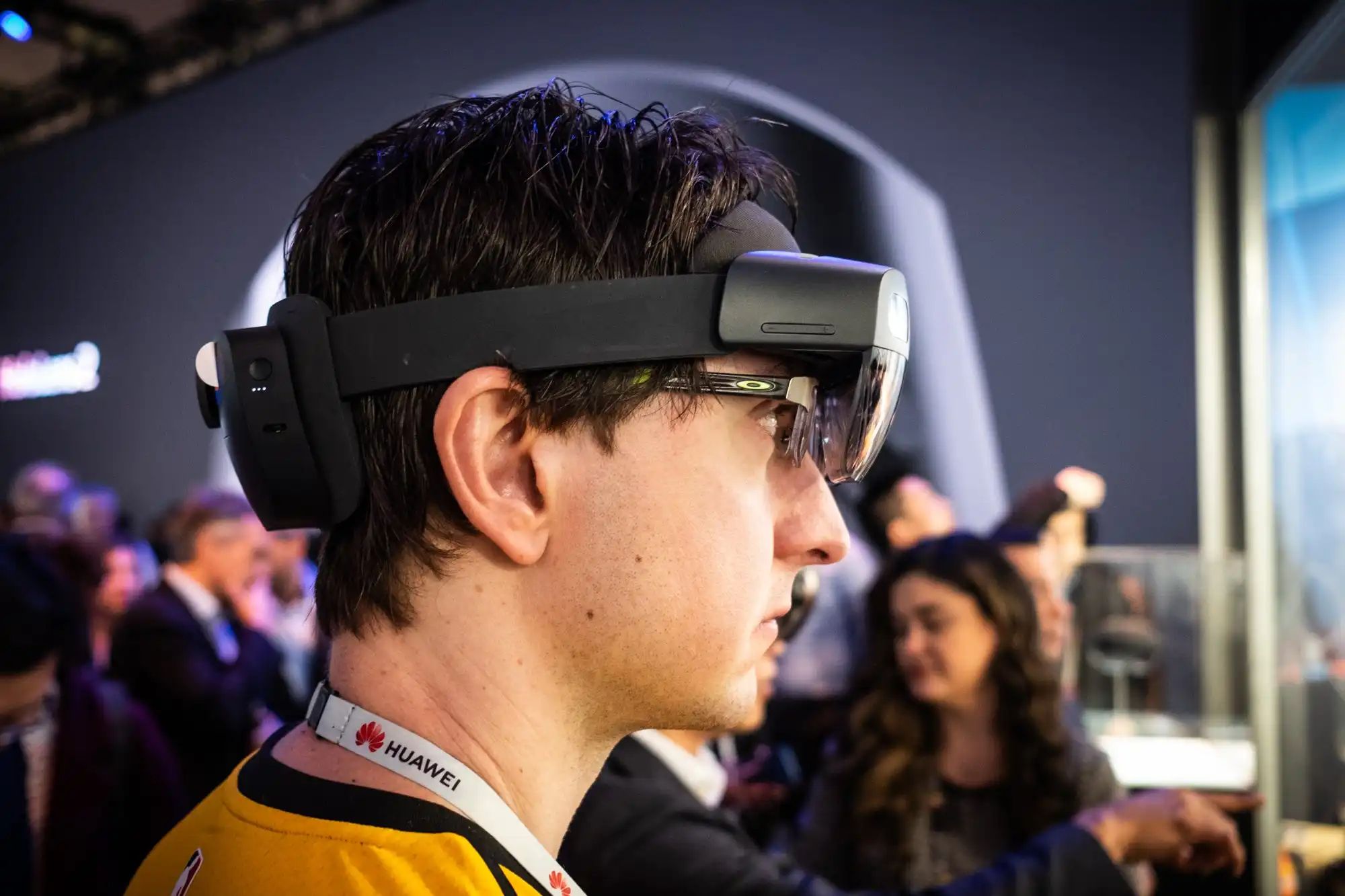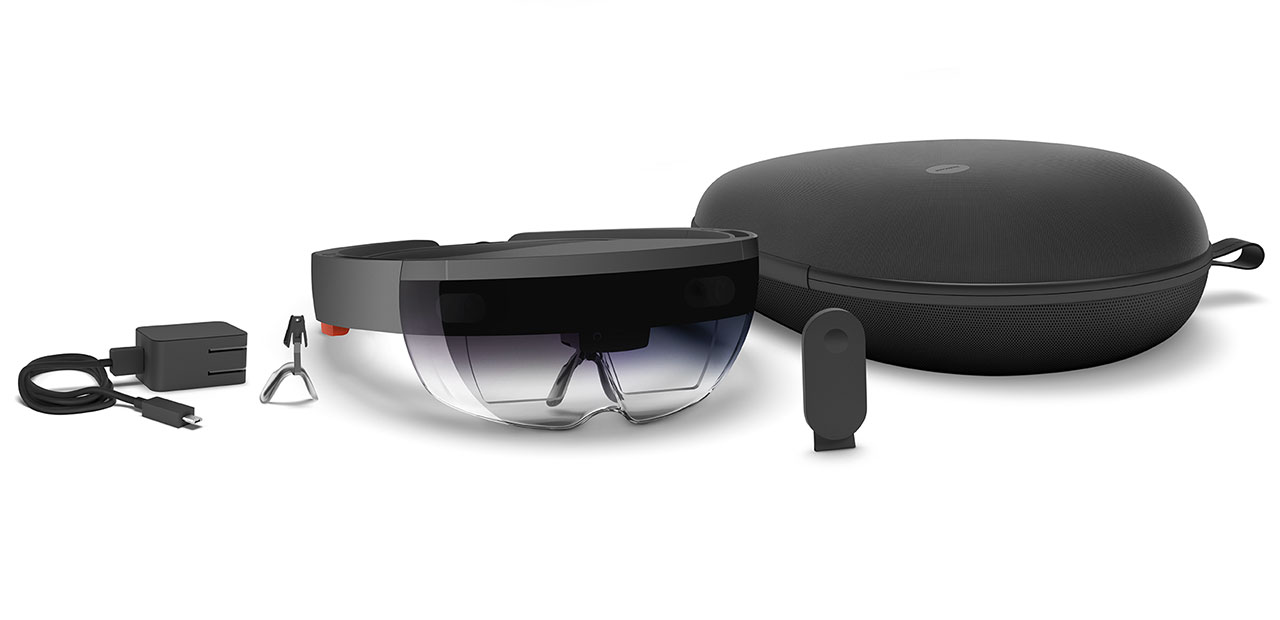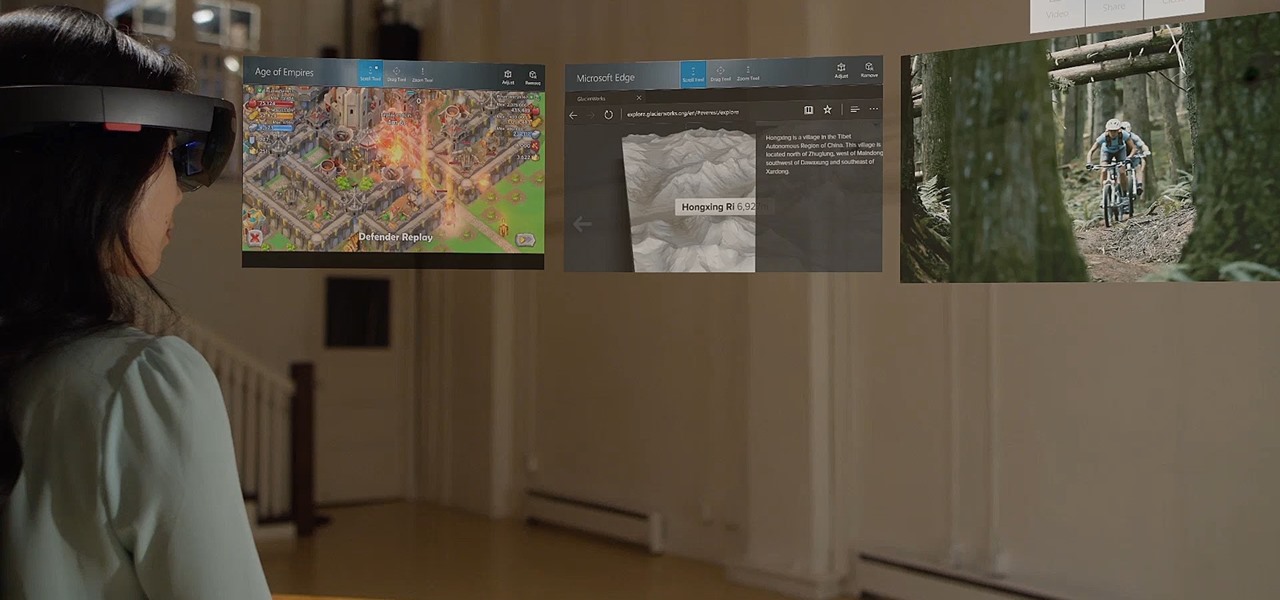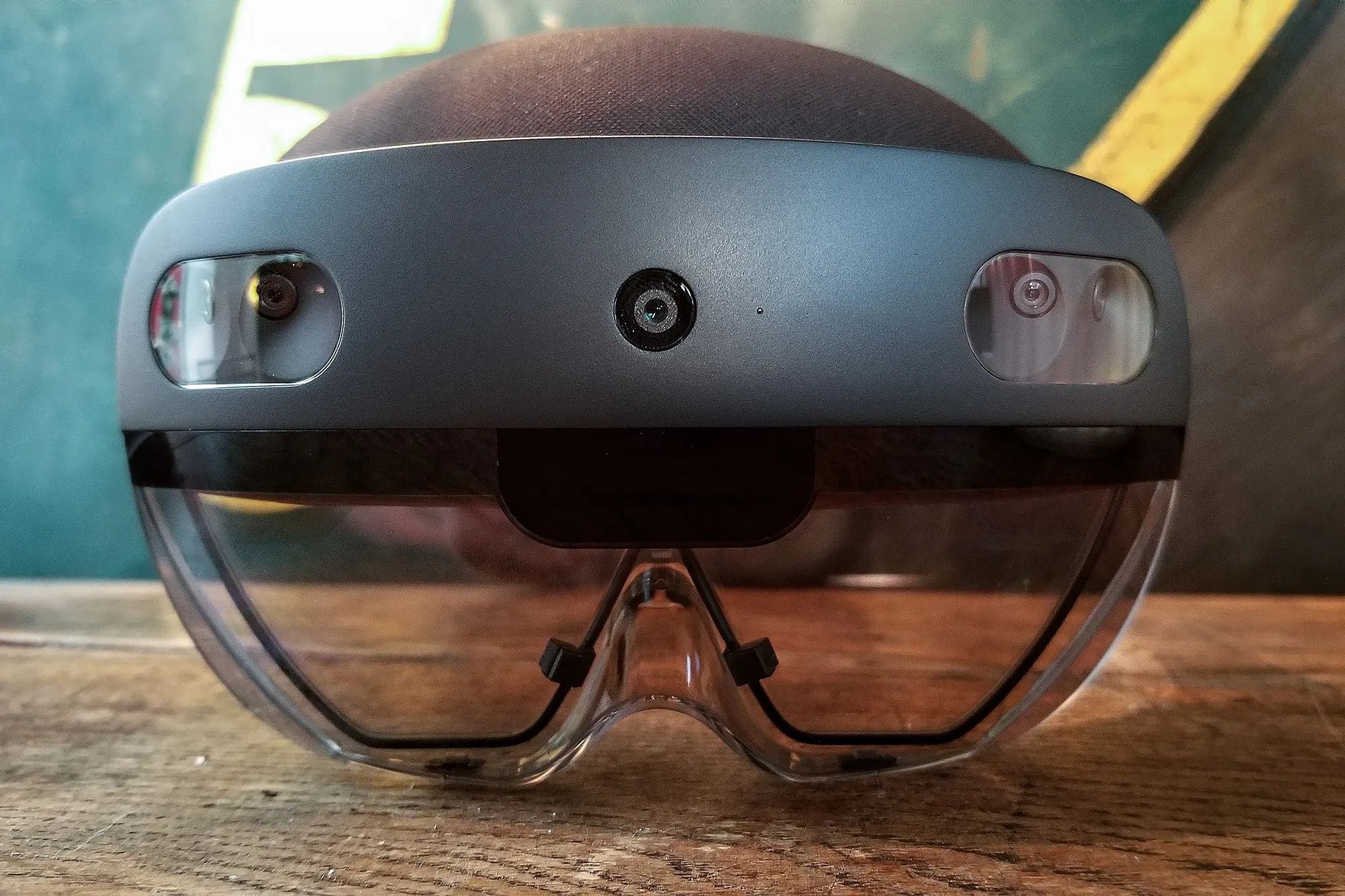Introduction
Microsoft HoloLens is a groundbreaking augmented reality (AR) device that has captivated the technology world since its development. It combines advanced optics, sensors, and holographic displays to deliver an immersive and interactive experience. The HoloLens allows users to overlay digital content onto the real world, seamlessly blending the physical and virtual realms.
With its sleek design and cutting-edge technology, the Microsoft HoloLens represents a major leap forward in the field of augmented reality. By enabling users to see and interact with holographic objects in their environment, HoloLens has the potential to revolutionize various industries, including design, engineering, healthcare, gaming, and education.
Unlike virtual reality (VR) headsets that transport users to entirely virtual worlds, the Microsoft HoloLens superimposes digital content onto the real world, creating an augmented reality experience. This unique approach offers a range of possibilities for both consumers and businesses, from immersive gaming experiences to dynamic workplace collaborations.
One of the key strengths of the Microsoft HoloLens is its ability to provide a truly untethered experience. Unlike other AR devices that require a connection to a computer or smartphone, the HoloLens is a self-contained unit. It features a built-in CPU, GPU, and HPU (Holographic Processing Unit), allowing it to process data and render holographic images without the need for external devices.
With the release of the second-generation HoloLens 2, Microsoft has further improved upon the original device’s capabilities. The HoloLens 2 offers a more comfortable fit, improved gesture recognition, and a larger field of view, making it an even more compelling choice for developers, creators, and enterprise users.
In the following sections, we will delve deeper into the features, applications, and pricing options for the Microsoft HoloLens. We will also compare it with other AR devices on the market and provide some important factors to consider before making a purchase decision.
The Development of Microsoft HoloLens
The development of Microsoft HoloLens can be traced back to the early 2010s when Microsoft began to explore the potential of augmented reality. Under the leadership of Alex Kipman, a visionary engineer at Microsoft, the team embarked on a journey to create a device that could seamlessly blend the physical and digital worlds.
The first iteration of the HoloLens, known as HoloLens Development Edition, was unveiled in 2015. This initial release targeted developers and enthusiasts who were eager to explore the possibilities of augmented reality. The device received critical acclaim for its innovative design and advanced capabilities, solidifying Microsoft’s position as a leader in the AR space.
Building upon the success of the original HoloLens, Microsoft introduced the HoloLens 2 in 2019. This new generation device featured significant improvements in terms of comfort, field of view, and interaction capabilities. The HoloLens 2 incorporated valuable feedback from developers and users, resulting in a device that better catered to the needs of its users.
One of the key advancements in the development of the HoloLens is the integration of the Holographic Processing Unit (HPU). This dedicated processor is responsible for executing complex tasks related to holographic rendering, spatial mapping, and gesture recognition. The HPU, coupled with other components like the CPU and GPU, enables the HoloLens to deliver seamless AR experiences with low latency and high accuracy.
Moreover, Microsoft has been actively working on expanding the software ecosystem for HoloLens. Through the Windows Mixed Reality platform, developers can create and publish applications specifically designed for immersive AR experiences. Companies in various industries, such as architecture, engineering, healthcare, and entertainment, have embraced the HoloLens and developed innovative solutions that leverage its unique capabilities.
Microsoft has also placed significant emphasis on collaboration and enterprise applications. The HoloLens allows multiple users to share and interact with holographic content simultaneously, enabling effective collaboration in virtual spaces. This opens up new possibilities for remote team collaboration, training simulations, and complex data visualization.
Overall, the development of Microsoft HoloLens showcases Microsoft’s commitment to pushing the boundaries of augmented reality technology. Through continuous innovation and improvement, Microsoft has been able to create a cutting-edge device that has the potential to revolutionize numerous industries and redefine the way we interact with digital content in the real world.
Features and Capabilities of Microsoft HoloLens
The Microsoft HoloLens is packed with an array of features and capabilities that make it a standout device in the augmented reality space. Let’s explore some of its key features:
- Holographic Display: The HoloLens features a high-resolution holographic display that allows users to see and interact with virtual objects overlaid onto the real world. This display provides stunning visuals and a lifelike experience, creating a seamless blend of real and digital environments.
- Spatial Sound: The device is equipped with spatial sound technology, which enables users to hear virtual sounds as if they are coming from a specific direction in their environment. This enhances the overall immersive experience and adds another layer of realism to holographic interactions.
- Gestural Interaction: HoloLens utilizes advanced gesture recognition technology to enable users to interact with holographic objects using their hands. By simply moving and gesturing, users can manipulate virtual content, select options, and perform various actions, making interactions more intuitive and natural.
- Head Tracking: Built-in sensors track the movement of a user’s head, allowing the HoloLens to accurately position holographic elements in real-time. This ensures that virtual objects stay in place relative to the user’s perspective, creating a convincing sense of depth and immersion.
- Holographic Processing Unit (HPU): The HoloLens is equipped with a specialized Holographic Processing Unit (HPU) that handles the complex computations and rendering required for holographic experiences. This dedicated processor enables the device to deliver high-performance visuals with minimal latency, resulting in smooth and responsive interactions.
- Connectivity: HoloLens supports Wi-Fi and Bluetooth connectivity, allowing users to connect to the internet, stream content, and interact with other devices. This connectivity opens up possibilities for remote collaboration, real-time data sharing, and accessing cloud-based applications and services.
These features, combined with the device’s sleek and ergonomic design, create a compelling AR experience that sets the Microsoft HoloLens apart from other augmented reality devices on the market. Whether it’s designing complex architectural models, conducting virtual medical training, or playing immersive games, the HoloLens offers a level of interactivity and realism that is truly transformative.
As Microsoft continues to refine and enhance the HoloLens technology, we can expect to see even more exciting features and capabilities in future iterations. With its potential to revolutionize industries and redefine the way we interact with the digital world, the Microsoft HoloLens represents a significant milestone in the evolution of augmented reality.
Applications and Uses of Microsoft HoloLens
The Microsoft HoloLens opens up a world of possibilities across various industries by offering a unique augmented reality experience. Let’s explore some of the applications and uses of this innovative device:
- Design and Engineering: In the field of design and engineering, the HoloLens allows professionals to visualize and manipulate 3D models in a real-world environment. Architects can showcase their designs in a more immersive manner, allowing clients to see and interact with virtual building designs. Engineers can use the HoloLens to inspect and simulate complex machinery, identify potential issues, and collaborate on solutions.
- Healthcare: The healthcare industry has also embraced the HoloLens for various applications. Surgeons can use the device to visualize medical images and overlay them onto a patient’s body during surgery, enhancing precision and reducing the risk of errors. Medical training programs can utilize the HoloLens to create realistic simulations, allowing students to practice complex procedures in a safe and controlled environment.
- Gaming and Entertainment: The gaming industry is another sector that has leveraged the capabilities of the HoloLens. With the device, gamers can experience a whole new level of immersion by interacting with holographic characters and objects in their physical space. Additionally, the HoloLens offers potential for interactive and augmented reality experiences at theme parks and entertainment venues.
- Educational Training: The HoloLens has immense potential in the field of education. It can be used to create interactive and engaging lessons that bring abstract concepts to life. Students can explore virtual environments, conduct virtual experiments, and engage in collaborative learning experiences. From astronomy to history, the HoloLens opens up new avenues for educational training and engagement.
- Remote Collaboration: Businesses can leverage the HoloLens to facilitate remote collaboration. Multiple users can don the HoloLens and interact with shared virtual content, enabling teams to collaborate on projects regardless of their physical location. This technology is particularly useful for companies with distributed teams or clients located in different parts of the world.
- Art and Design: Artists and designers can use the HoloLens to create immersive and interactive installations and exhibitions. This technology allows artists to combine physical and digital elements, offering viewers a unique and captivating experience. The HoloLens enables the exploration of new creative possibilities, pushing the boundaries of traditional art and design.
These are just a few examples of the diverse applications and uses of the Microsoft HoloLens. From enhancing productivity and efficiency in various industries to revolutionizing how we learn and experience entertainment, the HoloLens has the potential to reshape the way we interact with technology and the world around us.
As the technology continues to evolve and more developers explore its capabilities, the range of applications for the Microsoft HoloLens is only expected to grow. Whether it’s in the professional realm, educational institutions, or the entertainment industry, the HoloLens offers a new frontier of possibilities that can transform how we live, work, and play.
Pricing Options for Microsoft HoloLens
The Microsoft HoloLens is available in different pricing options, catering to various user needs and budgets. Let’s explore the pricing tiers for the HoloLens:
- HoloLens 2: The HoloLens 2, the latest iteration of the device, is available at a price of $3,500. This version offers improved comfort, a larger field of view, and enhanced interaction capabilities. It is targeted towards developers, enterprise users, and those who require advanced features for their projects or business applications.
- HoloLens Development Edition: The HoloLens Development Edition, which is the first-generation device, was initially released at a price of $3,000. However, it is no longer available for purchase directly from Microsoft. This version was primarily intended for developers and enthusiasts looking to explore the potential of augmented reality and create applications for the HoloLens platform.
- HoloLens Subscription: In addition to the upfront purchase options, Microsoft also offers a subscription plan for the HoloLens 2. This allows users to access the device and related services for a monthly fee of $125. The subscription includes benefits such as security updates, warranty coverage, and access to Microsoft Dynamics 365 Remote Assist, which enables remote collaboration and expert guidance.
It’s important to note that the pricing mentioned above is specific to the United States market and may vary in different regions. Additionally, Microsoft regularly evaluates and updates its pricing to reflect the evolving market dynamics and competition.
When considering the investment in the Microsoft HoloLens, it’s essential to take into account the potential benefits and returns it can provide for your specific use case. Businesses may find value in the device’s ability to enhance productivity, collaboration, and innovation, which can ultimately lead to cost savings and a competitive advantage.
For developers and creators, the HoloLens offers a platform to bring their ideas to life and tap into the growing market for augmented reality applications. The ability to develop and deploy HoloLens applications can open up new opportunities for revenue generation and industry partnerships.
Ultimately, the pricing of the Microsoft HoloLens reflects the advanced technology and capabilities it brings to the table. While it may not be accessible to every user or consumer, the HoloLens offers a powerful tool for those who can benefit from its unique features and applications.
It is recommended to visit the official Microsoft website or reach out to authorized resellers to get the most up-to-date and accurate pricing information for the Microsoft HoloLens.
Comparing Microsoft HoloLens with Other AR Devices
When it comes to augmented reality (AR) devices, the Microsoft HoloLens stands out as one of the pioneering offerings. However, there are also other AR devices available in the market that are worth considering. Let’s compare the Microsoft HoloLens with some of these devices:
- Magic Leap One: The Magic Leap One is a direct competitor to the HoloLens, offering a similar AR experience. Both devices use spatial mapping and gesture recognition to overlay digital content onto the real world. The HoloLens has an advantage in terms of its larger field of view, which provides a more immersive experience. However, the Magic Leap One is known for its lightweight and comfortable design.
- Google Glass Enterprise Edition 2: While not exclusively an AR headset, the Google Glass Enterprise Edition 2 offers some AR capabilities. It focuses more on providing information and hands-free interaction rather than full holographic experiences. The HoloLens outperforms the Google Glass in terms of immersive content and interactivity but comes at a higher price point.
- Meta 2: The Meta 2 is a tethered AR headset that offers a high-resolution display and a wide field of view. It provides an immersive AR experience, similar to the HoloLens. However, the Meta 2 requires connection to a powerful computer, limiting its mobility compared to the self-contained HoloLens.
- Apple ARKit: While not a standalone device, Apple’s ARKit is a software platform that enables developers to create AR experiences for iOS devices. It leverages the processing power and camera capabilities of iPhones and iPads to deliver AR content. The HoloLens surpasses the ARKit in terms of its immersive nature and hands-free interaction, as it provides a dedicated headset and sensors designed for AR experiences.
When comparing these AR devices, it’s important to consider factors such as the field of view, comfort, interactivity, mobility, and price. The Microsoft HoloLens excels in providing a wide field of view and a versatile platform for developers and enterprise users. Its self-contained design allows for more mobility compared to some of the tethered options in the market.
Moreover, the HoloLens’ dedicated Holographic Processing Unit (HPU) ensures high-performance rendering and low latency, resulting in smooth and responsive holographic interactions. While the pricing of the HoloLens may be higher than some of its competitors, it also offers advanced capabilities and a robust ecosystem for AR development.
Ultimately, the choice of AR device depends on the specific use case and requirements of the user or organization. It’s important to assess factors such as the desired level of immersion, application compatibility, and the need for mobility when making a decision.
As technology advances and AR devices continue to evolve, we can expect to see more options and advancements in the market. Each device has its own strengths and weaknesses, and it is crucial to select the one that best aligns with the intended applications and goals.
Factors to Consider Before Purchasing Microsoft HoloLens
Before purchasing the Microsoft HoloLens, it is important to consider several factors to ensure that it aligns with your needs and expectations. Let’s explore some key considerations:
- Intended Use: Determine the primary purpose for acquiring the HoloLens. Whether it’s for professional use, gaming, or educational applications, understanding your specific use case will help evaluate the device’s relevance and potential benefits.
- Price: The pricing of the HoloLens, as well as any additional accessories and software licenses, should be taken into account. Consider your budget and the value the device can bring to your work or personal projects.
- Compatibility and Application Support: Assess the compatibility of existing software and applications with the HoloLens. Research the availability of the necessary tools and resources to develop or leverage AR content for the HoloLens platform.
- User Experience: Consider factors such as comfort, weight, and ergonomics. Evaluate how long you intend to wear the device and ensure it provides a comfortable and immersive experience without causing fatigue or discomfort.
- Interactivity and Input Methods: Understand the available input methods, such as gesture recognition, voice commands, and controller support. Consider which methods align with your preferences and intended use to ensure a seamless and intuitive interaction experience.
- Content and Ecosystem: Research the availability of apps, games, and content for the HoloLens. Assess the size and vibrancy of the developer community, as well as the support provided by Microsoft, to ensure ongoing updates and access to a wide range of experiences.
- Connectivity Requirements: Consider whether you require Wi-Fi or cellular connectivity for your intended use. Evaluate the need for real-time data streaming, cloud services, or remote collaboration and ensure the device meets these connectivity requirements.
- Development and Support: If you are a developer or organization, consider the availability of development tools, documentation, and support provided by Microsoft. Evaluate the community forums and developer resources to ensure adequate support for creating and deploying HoloLens applications.
By carefully considering these factors, you can make an informed decision about whether the Microsoft HoloLens is the right device for you or your organization. It’s important to align your expectations, use cases, and budget with the capabilities and limitations of the device to ensure a successful integration into your workflow or projects.
Additionally, staying informed about the latest developments and advancements in the AR industry can provide valuable insights into the future of the HoloLens and potential enhancements that may influence your decision, making it a worthwhile investment for your specific needs.
Conclusion
The Microsoft HoloLens represents a significant leap forward in the world of augmented reality. Its groundbreaking technology, cutting-edge features, and diverse range of applications make it an enticing device for developers, businesses, and consumers alike.
With its ability to overlay digital content onto the real world, the HoloLens opens up new possibilities in fields such as design, engineering, healthcare, education, gaming, and more. The device’s holographic display, spatial sound, gestural interaction, and head tracking capabilities create an immersive and interactive AR experience.
When considering the purchase of a HoloLens, it is important to evaluate factors such as intended use, price, compatibility, user experience, interactivity, content ecosystem, connectivity requirements, and development and support. These considerations will help determine whether the HoloLens aligns with your specific needs and provides value for your projects or applications.
While the HoloLens stands out among other AR devices, it is crucial to compare it with competing offerings to ensure that it meets your requirements and preferences. Devices such as the Magic Leap One, Google Glass Enterprise Edition 2, Meta 2, and Apple ARKit offer their own unique features and capabilities that may suit different use cases.
As the AR industry continues to advance, it is important to stay informed about updates and developments in HoloLens technology and explore the expanding ecosystem of applications and content. This will ensure that you can leverage the full potential of the HoloLens and stay at the forefront of augmented reality innovation.
In conclusion, the Microsoft HoloLens is a groundbreaking AR device that has the potential to revolutionize how we interact with digital content in the real world. Its advanced features, wide range of applications, and growing developer community make it a device worth considering for those looking to explore the possibilities of augmented reality and shape the future of technology.







